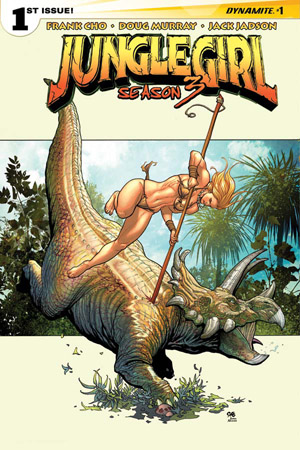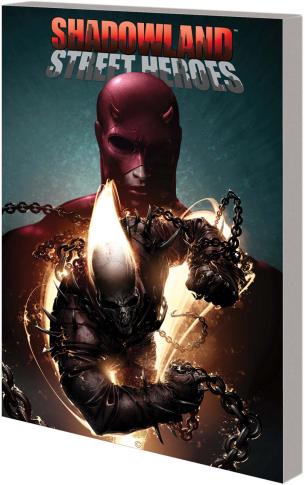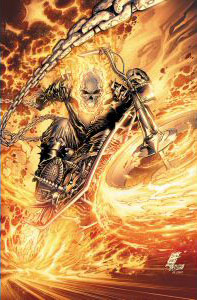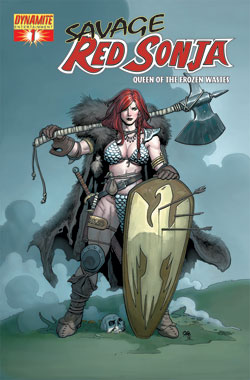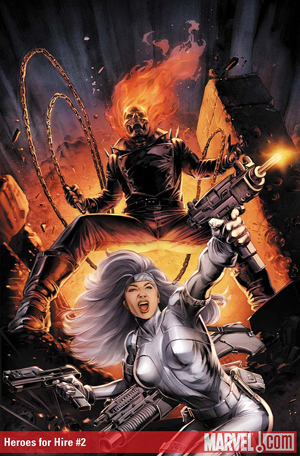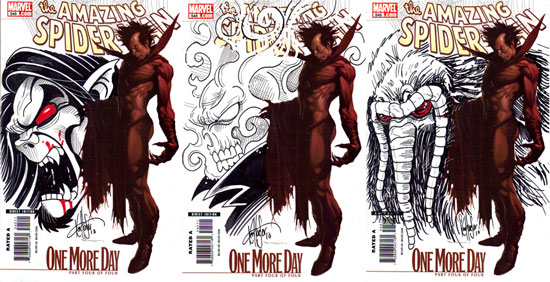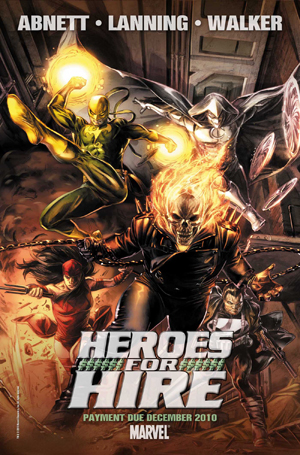|

|
GHOST RIDER Ghost Rider is the name of several fictional supernatural anti-heroes in the Marvel Comics universe. Marvel had previously used the name for a Western character whose name was later changed to 'Night Rider' and subsequently to 'Phantom Rider'.
The first supernatural Ghost Rider is stunt motorcyclist Johnny Blaze, who, in order to save the life of his mentor, agreed to give his soul to "Satan" (later revealed to be an arch-demon named Mephisto). Instead, his soul was bonded with the entity called Zarathos. When emitting Zarathos's Powers, Blaze's head became a flaming skull and he wielded a fiery motorcycle and trademark blasts of hellfire from his skeletal hands. He starred in an eponymous series from 1973-1983.
The subsequent Ghost Rider series (1990-98) featured Daniel Ketch as a new Ghost Rider. After his sister was injured by gangsters, Ketch came in contact with a motorcycle which had somehow been mystically enchanted to contain the essence of a "Spirit of Vengeance." This spirit had originally been a Puritan man named Noble Kale, an ancestor of both Blaze and Ketch. Johnny Blaze reappeared in this series as a supporting character and was revealed to be Ketch's brother.
Following the western comics character who originally used the name, this Ghost Rider first appeared in Marvel Spotlight vol. 1, #5 (Aug. 1972), created by writers Roy Thomas and Gary Friedrich and artist Mike Ploog.
Johnny Blaze, a motorcycle stunt performer in a traveling circus, sold his soul to who he believed was Satan but was actually the demon Mephisto (a retcon), in order to save the life of his stepfather, "Crash" Simpson. Blaze was bound with the demon Zarathos and transformed into a leather-clothed skeleton, his head cloaked in a sheath of flame. The character received his own series in 1973, with penciller Jim Mooney handling most of the first nine issues. Several different creative teams mixed-and-matched until penciller Don Perlin began a long stint with #26, eventually joined by writer Michael Fleisher through #58. This Ghost Rider's career ended when Zarathos fled Blaze's body in issue #81 (June 1983), the finale, in order to pursue Centurious, a villain introduced near the end of the series' run with whom Zarathos had a history.
Blaze would mistake Noble Kale (an earlier Ghost Rider, the first known to have utilized the name in links with the supernatural) for Zarathos during the subsequent Ghost Rider series (1990-1998), and after attempting to destroy him, eventually became an ally. Johnny, like his long-lost brother, Danny Ketch (see below), are direct descendants of Kale. (Johnny's true last name is Blaze, inherited from his father Barton Blaze. Barbara and Daniel Ketch's true last names remain unknown as their father might or might not be Barton Blaze).
Johnny Blaze was supposed to have become Kale's next host, but because of a deal their mother, Naomi, made with Mephisto, Blaze was "spared" this fate. Instead, Blaze became the host for another entity, Zarathos, who had been stripped of his memories and was originally under Blaze's control. As the series progressed, that control faded and Zarathos' true personality was evident whenever Ghost Rider was unleashed.
Thomas, Marvel's editor-in-chief at the time, described the character's genesis:
" I had made up a character as a villain in Daredevil - a very lackluster character - called Stunt-Master... a motorcyclist. Anyway, when Gary Friedrich started writing Daredevil, he said, "Instead of Stunt-Master, I'd like to make the villain a really weird motorcycle-riding character called Ghost Rider." He didn't describe him. I said, "Yeah, Gary, there's only one thing wrong with it," and he kind of looked at me weird, because we were old friends from Missouri, and I said, "That's too good an idea to be just a villain in Daredevil. He should start out right away in his own book." When Gary wasn't there the day we were going to design it, Mike Ploog, who was going to be the artist, and I designed the character. I had this idea for the skull-head, something like Elvis' 1968 Special jumpsuit, and so forth, and Ploog put the fire on the head, just because he thought it looked nice. Gary liked it, so they went off and did it. "
Friedrich on the above, in 2001:
" Well, there's some disagreement between Roy, Mike and I over that. I threatened on more than one occasion that if Marvel gets in a position where they are gonna make a movie or make a lot of money off of it, I'm gonna sue them, and I probably will. ...It was my idea. It was always my idea from the first time we talked about it, it turned out to be a guy with a flaming skull and rode a motorcycle. Ploog seems to think the flaming skull was his idea. But, to tell you the truth, it was my idea.
Daniel Ketch
The third Ghost Rider debuted in Ghost Rider vol. 2, #1 (May 1990). Daniel Ketch and his sister Barbara, attacked by ninja gangsters, fled and hid in a junkyard where Daniel found a motorcycle bearing a mystical sigil. Upon touching the sigil, he was transformed into the Ghost Rider. This Ghost Rider was nearly identical to the previous, although his costume and bike had undergone a modernized tailoring. He thrashed the gangsters, but was unable to save Barbara, who had been critically wounded and slipped into a coma. She was eventually killed by Blackout, a lieutenant of the very organization responsible for her state and whom Ketch had acquired as a mortal enemy when his face was scarred by the Ghost Rider's demonic fire.
When Ghost Rider became a part of the Midnight Sons, he died twice in the process. The first person who killed Ghost Rider was the vampire hunter Blade, who was at the time possessed by the Darkhold. He was soon revived by the Darkhold Redeemers, along with everyone else who was killed by Blade. The second time he died was when he was fighting Zarathos, but as before, he was once again reborn.
It was later revealed that Ketch and Blaze were long-lost brothers and that their family were the inheritors of a mystical curse related to the Spirits of Vengeance. Ketch eventually died, but the Spirit of Vengeance that had been bound to him through the bike's talisman lived on. Peter Parker: Spider-Man #93 (July 1997) revealed that Ketch was still alive, and he rebonded with the Noble Kale Ghost Rider.
Unlike Blaze, the Ketch Ghost Rider possessed a "Penance Stare" that made the target experience all the pain and suffering he or she had caused others - as the target discovered, this was a punishment far, far worse than death. (However, as of recent times, the Blaze Ghost Rider has also been able to use this ability.) He possessed Hellfire, as did the Zarathos/Blaze version, as well as the ability to destroy the undead. Issue #91 (Dec. 1997) revealed him as Marvel's incarnation of the Angel of Death/Judgment.
In addition, Ketch and Noble Kale actually worked together to some extent, unlike Blaze and Zarathos, who battled for dominance and control over their shared body. Kale had a compassionate side and while there were times that he seemed tempted to simply take over completely, he refused to do so, though he felt remorse at condemning Daniel to only being able to live his life out half the time, while he dominated the other half. Kale and Ketch, like Blaze and Zarathos, could sometimes communicate through dreams, and in at least one issue communicated via messages written on a mirror in lipstick.
The series ended with issue #93 in February 1998, ending with a cliffhanger, as the series was cancelled prematurely by Marvel management at the time. Throughout the next 9 years, it was known that the 94rth issue was completed, and many readers wondered if that unpublished final issue would ever get released. Marvel finally published the unpublished final issue as the Ghost Rider Finale (Jan. 2007), which reprinted Ghost Rider Vol. 2 #93 and the unpublished issue #94, giving a proper conclusion to the Daniel Ketch incarnation of Ghost Rider. The cover reads as Ghost Rider #94, but does also say Ghost Rider Finale as well (with the comic's legal indicia, printed on the title page, listing the comic as Ghost Rider Finale).
After the Ghost Rider/Ketch comic series Johnny Blaze has since regained his title as Ghost Rider and is the current modern day Ghost Rider.
Johnny Blaze returns
A six-issue miniseries, again featuring Blaze as the Ghost Rider, debuted in 2001 under the Marvel Knights imprint. Subtitled "The Hammer Lane," it was written by Devin Grayson and penciled by Trent Kaniuga. In this arc, Blaze finds himself once more able to become the Ghost Rider after spending some time free of the curse.
A second six-issue miniseries, by writer Garth Ennis and artist Clayton Crain, subtitled "Road to Damnation," debuted November 2005. This series also featured Blaze and focused on his futile attempts at escaping from Hell. His Powers here include being able to breathe hellfire like a dragon and launching chains from his throat.
In July 2006, a new ongoing monthly series, titled simply Ghost Rider, began. Written by Daniel Way with art by Mark Texeira, it takes place after the Ennis miniseries. It features Blaze still in Hell, desperately trying to escape. At the end of the first issue, he is manipulated into bringing Satan to Earth. This particular incarnation of Ghost Rider features Blaze as the human host. Blaze's Ghost Rider appearance is similar to Daniel Ketch's, a change that assistant editor Micahel O'Connor attributes to the manifestation of Ghost Rider's Powers themselves.
Powers and abilities
The Ghost Rider is a human who can transform into a demonic motorcyclist with a flaming skull and supernatural Powers. The motorcycles he rides can travel faster than conventional motorcycles and can perform such otherwise impossible feats as riding up a vertical surface or across the surface of water. The Danny Ketch/Noble Kale version of Ghost Rider was capable of traveling into the air while on the bike, but this power appeared only twice in the entirety of the character's run.
Johnny Blaze - When Blaze transformed, his motorcycle caught fire, although later in the comics, he could create a cycle from pure hellfire. Hellfire is a supernatural flame which burns the soul of an individual, and not the body. He was also capable of projecting hellfire as a weapon. In Ghost Rider form, he displays supernatural strength and resilience. Blaze can perform supernatural stunts on his motorcycle. Later, Blaze developed Danny Ketch's Powers in addition to his own, with control over the "Penance Stare" and the ability to manipulate an enchanted chain. He also gained new abilities, such as hellfire breath and the ability to spew chains from either his throat or chest. Finally, he gained the ability to travel between the incorporeal and material planes.
Daniel Ketch - When Ketch transformed, his motorcycle underwent a more radical transformation, changing from a conventional into a high-tech motorcycle. Along with flaming wheels, the bike includes a shield-like battering ram on the front. As the Ghost Rider, Ketch uses a bike chain, much like a bike lock, that can grow in length, is very resilient, and can transform into various other weapons. Daniel's most famous power is the Penance Stare: when in close combat, he locks eyes with his victim and makes him or her feel every pain that individual has ever inflicted on anyone in their lifetime. An attempt to use the Penance Stare on the symbiotic being Venom resulted in Ghost Rider being knocked unconscious. This incarnation of the Ghost Rider also originally could transform only "when innocent blood was spilled" and had to touch the gas cap of his motorcycle before the transformation process would begin. He later overcame these dependencies.
Naomi Kale
Naomi Kale was revealed to be the mother of John, Daniel, and Barbara in a "Flashback" issue of Ghost Rider (vol. 2). This issue, numbered # -1 (negative one), showed Naomi as a terminally ill woman who had also been host to the Ghost Rider. Prior to her death at the hands of Mephisto, Naomi revealed arrangements for spells to be placed on Johnny (filling his body with hellfire and stopping possession). Naomi hoped this would end the curse of her bloodline, though this was later revealed to simply skip Johnny, resulting in Barbara being the inheritor.
She displayed a wide knowledge of the background of Noble Kale, and possessed the brand on her left hand. After a brief confrontation with Mephisto in Cypress Hills Cemetery, she finally succumbed to her illness. She was buried along with the motorcycle. Thirteen years later, the bike was unearthed and surrounded by car wrecks, setting the scene for the events of Ghost Rider vol. 2, #1.
Other Spirits of Vengeance
There have been three other Spirits of Vengeance in the Marvel universe:
Vengeance
Main article: Vengeance
Michael Badilino, a former member of the New York City Police Department, is one third of an "Organic Medallion of Power"; the other two were Ketch and Blaze. (The Medallion itself was never explained in any true detail.) He possesses Powers more in line with those of the Zarathos version of Ghost Rider, although he did possess the Penance Stare and his motorcycle also seemed to share characteristics with the version used by Noble Kale. His appearance was distinguished by a deep purple skull, large fangs protruding from his upper jaw, and backswept curved horns on the top of his skull.
In his superhuman form, Badilino was called Vengeance, and originally attempted to kill the Ghost Rider, believing him to be Zarathos. Vengeance later became the ally of Ghost Rider and Johnny Blaze. Vengeance would also take on the role of the Ghost Rider and even semi-seriously referred to himself by that name when confronted by Spider-Man shortly after the apparent death of Ghost Rider in battle with Zarathos and acolytes The Fallen. Vengeance killed himself, along with the villain Hellgate, by triggering a massive explosion through his Hellfire, the source of the mystical flames that encompass the bones of both Vengeance and Ghost Rider.
Vengeance reappears in the last four issues of Ghost Rider Vol. 2, involved in Blackheart's plans to kill Noble Kale. Vengeance aides the Ghost Rider in the ensuing battle, destroying Blackheart and ruling Hell during Ketch's absences.
Ghost Rider 2099
Main article: Ghost Rider 2099
Ghost Rider 2099Zero Cochrane, who in the Marvel 2099 alternate timeline is a cybernetic take on the Spirit of Vengeance, was not a supernatural being, but a cybernetic being with a digitized copy of Cochrane's mind. He encountered a futuristic counterpoint to Michael Badilino's Vengeance. The Ghost Rider of 2099 appeared to drop out of existence during the consolidation of the 2099 books into a single title called 2099 World of Tomorrow. He subsequently appeared in the 2099 "epilogue" book Manifest Destiny, arguing with the AIs that empowered him.
The Spirit of Vengeance
This version debuted in Guardians of the Galaxy, set in an alternate future of the Marvel Universe, as a member of an offshoot group calling themselves the Galactic Guardians. This Ghost Rider was a religious zealot, embittered, for reasons never completely explained, toward a church proclaiming it would produce its god in the flesh. That being, the Protege, was destroyed by the Celestial Scathan the Approver. This Ghost Rider referred to himself simply as the Spirit of Vengeance.
Caretaker
Sam Elliott portrayed the Caretaker in the 2007 film based on Ghost Rider. This version of the character, however, was not a member of the Blood, of which there is no mention in the movie, but in fact was Johnny Blaze's predecessor to the Ghost Rider title, having been subjected to the same curse 150 years before. In the film, the Caretaker turns out to be Carter Slade, another character owned by Marvel Comics that was originally named Ghost Rider, but later changed to Phantom Rider to make way for the new version. But Sam Elliot's depiction of this character is more along the lines of the Caretaker, in terms of emotion, or lack thereof. At one point, he even transforms into a Ghost Rider-style version of Carter Slade, complete with a flaming skull, nearly-charred clothes, and a mystical horse on fire.
Movies
A Ghost Rider movie starring Nicolas Cage was released on February 16, 2007. The character faces Blackheart and his father, Mephistopheles. The film tells the origin story of the Johnny Blaze incarnation; however, he possesses the "Penance Stare" power and the looks of the Danny Ketch Ghost Rider. He wields a length of chain which he frequently uses as a lasso and deftly whips around his torso. Aside from being infused with hellfire, the chain doesn't appear to have any unusual properties. When transformed, his motorcycle more closely resembles Vengeance's. He's also apparently able to transform an unloaded rifle into a weapon capable of firing blasts of hellfire, like the hellfire gun Johnny Blaze used in the comic books when he teamed up with the Danny Ketch Ghost Rider during the "Spirits of Vengeance" era. The film depicts Ghost Rider as a living embodiment of the element fire, facing off against fallen angels representing the elements of earth, water, and air. Blaze is able to become Ghost Rider and maintain his Powers only at night or in shadow, and while in the presence of evil. However, in striving to master his curse, he once manages to generate hellfire while alone during the day, indoors.
Television commercial
Ghost Rider appears in a 2007 TV commercial for the Jackson Hewitt tax-preparation service, intended as a tie-in promotion with the 2007 movie, showing him handing in a burning W-2 form. At the end, he sets off the office sprinkler system.
Animation
Ghost Rider made a cameo appareance in Spider-Man and His Amazing Friends in "The Prison Plot" as one of the illusions shown by Mastermind.
Ghost Rider has appeared in the Incredible Hulk animated series on the UPN Network, and in the 1994 Fantastic Four episode "When Calls Galactus." Richard Grieco provided Ghost Rider's voice on both occasions. (This Ghost Rider was the Daniel Ketch version, as he used the penance stare both times.)
The Ghost Rider also appeared briefly as a memory in Gambit's mind during the 1990s Fox Broadcasting Company X-Men animated series; he did not speak on that occasion.
Literature
The Ghost Rider appears in a novelization of the film released on February 16, 2007. This book ties the movie incarnation of the character to the mainstream Marvel universe, with references to Doctor Strange and Matt Murdock/Daredevil. In the novelization, Blaze takes on the general appearance and most of the Powers of the Daniel Ketch Ghost Rider, and seems to have at least partial control over the Ghost Rider, though the entity also seems to have a personality of its own. Neither seems to have any attempt to dominate the other, though Blaze learns how to suppress and will the change by the book's end.
Video games
Ghost Rider is a supporting character in the 1995 side-scrolling beat 'em up video game, Spider-Man & Venom: Separation Anxiety.
Ghost Rider makes a cameo appearance riding up the side of a building in the "Race to the Bugle" level of the 2000 Spider-Man Activision game.
Ghost Rider is featured as a secret character in the video game Marvel: Ultimate Alliance. The player unlocks him when you reach Mephisto's Realm, but must trade another character to free him; however, soon afterward both Ghost Rider and the traded character are freed. Vengeance and the Phantom Rider are both unlockable as costumes for Ghost Rider in the game.
2K Games and Climax released a game based on the Ghost Rider movie on February 13, 2007. The game is a sequel to the movie, in which players can play Ghost Rider both on foot or on the Hellcycle. The on-foot combat is very similar to that of God of War, due to almost exactly the same chain attacks. When on the Hellcycle, Ghost Rider is still capable of performing many of the same chain attacks, and can shoot hellfire. The hellfire attack can later be upgraded so that it fires three projectiles at once and lock on to their targets. After defeating Blackheart, players gain the ability to replay not only as Ghost Rider, but Vengeance and Ghost Rider 2099 , both of whom have the same abilities as Ghost Rider. Players are also able to play as Blade, who has two main katana attacks and heals by sucking the blood of enemies. If players complete the game on extreme difficulty, they unlock classic Ghost Rider.
Parodies and allusions
The video game boss Hellbiker in Shin Megami Tensei III: Nocturne.
Hanzo Hasashi (Scorpion) in the Mortal Kombat games has a spectral form with a flaming skull like Ghost Rider.
Merchandise/toys
In addition to a standalone line of Ghost Rider toys featuring Ketch's incarnation and his allies and foes, Toy Biz produced a model kit ("Advanced Level 3", the only one in that particular series) of Kale with his motorcycle. It stands 8.75 inches tall, and needs glue for completion.
Three Ghost Rider action figures appear in the Marvel Legends series, one each of Danny Ketch, Johnny Blaze, and Johnny Blaze in mid-transformation. A Vengeance figure was released in the "Legendary Riders" series.
Medicom Toy Co. has produced two Ghost Rider figures in conjunction with the new Ghost Rider movie. One is a super-deformed vinyl collectible doll that stands 5 inches tall and the other is from the Medicom Toy Co. Real Action Hero 12-inch figure collection and features a highly detailed rendition of Ghost Rider in 12-inch form.
Pop culture
Rapper/actor Method Man is a Ghost Rider fan who sometimes uses the alias "Johnny Blaze."
The song "Ghost Rider," written by the New York City punk/electronic band Suicide (Alan Vega and Martin Rev) appears on the band's self-titled 1977 album. The song has been covered by such bands as the Rollins Band and R.E.M.
The Danish rock band The Raveonettes has a song entitled "Attack of the Ghost Riders." Lead singer Sune Rose Wagner is seen as Ghost Rider at the end of the accompanying video. The band also covered the song "Ghost Rider" on the Suicide tribute album.[citation needed]
In 2005, the all-girl Filipino rock band Prettier Than Pink recorded the tribute ballad "Johnny Blaze" for the CD Chop Suey (Sutton Records).
Texas Horror Rock band The Horrifics had a song entitled "Forever the Night" about Johnny Blaze/Ghost Rider.
This article uses material from Wikipedia and is licensed under the GNU Free Documentation License.All material is compiled from numerous sources and may not be accurate. Dynamic Forces, Inc and all of its subsidiaries cannot guarantee the validity of the content. |
 |



